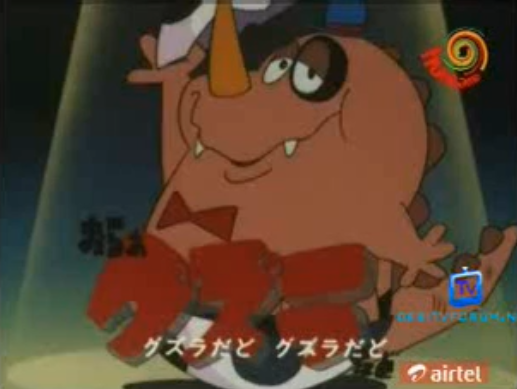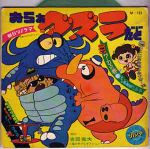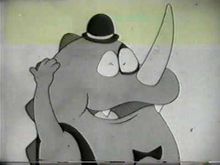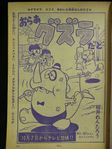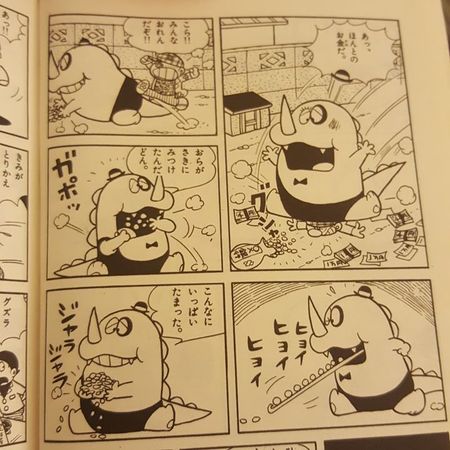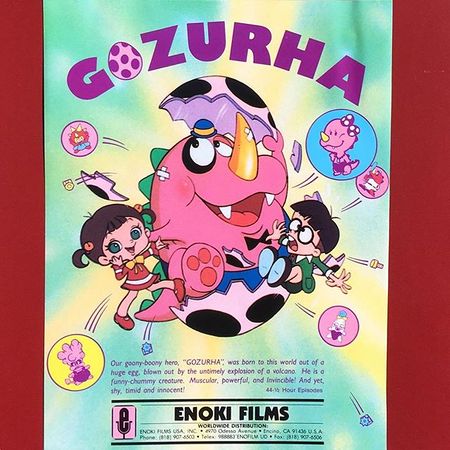Oraa Guzura Dado (partially found original anime audio and manga series; 1967-1968, 1987-1988)
A screenshot from the 1987 version of the series.
Status:
Partially Found (1967 anime, manga)
Found (1987 anime)
Oraa Guzura dado (おらぁグズラだど Hey, I'm Guzura!) is a 1967 black and white anime series directed by Hiroshi Sasagawa and produced by Tatsunoko Productions. It also had a manga adaptation. In 1987, the series was remade in color.
1967 anime
The original series aired from October 7th, 1967, till September 25th, 1968, and was composed of 104 segments (52 episodes). It was the last black and white anime produced by Tatsunoko Production. Oraa Guzura dado came along during the kaiju boom, a surge of tokusatsu related media that kicked off in the 60s. The series was an international hit, there were a few toys and merchandise produced and the show was exported to other countries, such as Australia, where it recived an english dub with the name "Gazula the Amicable Monster".[1]
Staff
Chief Director
- Hiroshi Sasagawa
Script
- Haruya Yamazaki (eps 7-8, 11-12, 19-20, 24, 27-35, 38, 43-44)
- Hiroshi Sasagawa (ep 1)
- Hisayuki Toriumi (ep 9)
- Jinzo Toriumieps (5, 10, 14, 16-17, 25)
- Masatsugu Nagai (ep 42)
- Motoyoshi Maesato (ep 36)
- Osamu Jinnoeps (7, 11, 15-16, 18, 20-23, 25-26, 28, 30, 32, 35, 37-38, 41-42, 44-45, 50)
- Rentaro Itai
- Satoshi Dezaki (ep 10)
- Shinichi Murabayashi (eps 4-5, 27)
- Takashi Kusakawa (eps 31-32)
- Tsunehisa Itō (eps 6, 14, 17-18, 34)
- Yoshiaki Yoshida (eps 19, 40, 47)
- Yoshitake Suzuki (eps 2-3, 9, 15, 39-40)
- Yūgo Serikawa (ep 4)
- Yûsaku Sakamoto (ep 6)
Voice actors
- Kei Tomiyama as Papa
- Mie Azuma as Bonta
- Shigeru Asou as Mama
- Toru Ohira as Guzura
- Yoshiko Matsuo as Suzuko
Episode Director
- Hiroshi Sasagawa
- Hisayuki Toriumi
- Mineo Fuji
- Renzo Kinoshita
- Ryousuke Takahashi
- Seitarô Hara
- Takashi Nishioka
Music
- Kousuke Onozaki
Original creator
- Hiroshi Sasagawa
Art Director
- Mitsuki Nakamura
Animation Director
- Jinzo Toriumi
Sound Director
- Yasunori Honda
Producer
- Tatsuo Yoshida
Animation
- Juji Mizumura
- Masami Suda
- Takashi Saijo
Chief animator
- Yûsaku Sakamoto
Planning
- Jinzo Toriumi
Sound Effects
- Shoji Kato
Status
The series is considered partially lost. It is belived that Tatsunoko Productions has every episode, but this claim is uncertain. Most episodes of this series were found via Brazilian airings, either on youtube or bootleg DVDs, but missing their original japanese audio.
Manga
Onboro Kaijū Kuzura (オンボロ怪獣クズラ Worn-out Monster Kuzura) was a 4 chapter manga series (erroneously referred to as a oneshot in most places on the internet) drawn and written by Hiroshi Sasagawa, serialized in the Weekly Shōnen Sunday magazine from 1966 March 13th to early 1967[2], which would serve as the foundation for the Oraa Guzura Dado anime series. This manga series has never been republished outside of its original serialization in the magazine, becoming mostly forgotten to time.
Later on, in 1967, a manga adpatation of the anime series would start serialization on Weekly Shōnen Sunday, as well as in children's magazines owned by Shogakukan. Tankōbon volumes compiling the chapters featured in Weekly Shōnen Sunday (Drawn by Rentaro Itai and written by Hiroshi Sasagawa) have been realesed several times, the most recent being 2008, however, the chapters in children's magazines (drawn by Jiro Ota, Hideo Shinoda and Shigeru Matsuyama) have never been republished in any shape or form since their original serialization.
1987 Anime
Aired between October 12th, 1987, and September 20th, 1988, and was composed of 88 segments (44 episodes; 2 segments per episode). This was a color remake of the original series. Most of the scenes were fully redrawn, however they were often drawn over the original frames. This series was exported to multiple other countries, but never recived an english dub, unlike its predecessor.
Status
The series was considered partially lost, with only the footage being avaible via foreign dubs, until around April 2020, when the series was released on Amazon in Japan[3].
Gallery
External Link
- Blogpost showcasing 1966's Weekly Shōnen Sunday No. 10, featuring scans of the first chapter of Onboro Kaijū Kuzura Retrieved 19 Mar '24
- Youtube playlist featuring episodes of the 1967 series, reconstructed using footage from brazillian dubbed episodes and audio from the 1987 colorization Retrieved 19 Mar '24
References
- ↑ "Mike Toole Presents: A Crash Course in Godzilla Cartoons" by Mike Toole Retrieved 08 Jan '22
- ↑ "Hiroshi Sasagawa works list" Retrieved 19 Mar '24
- ↑ 1987 series on Amazon Japan Retrieved 25 Apr '20
